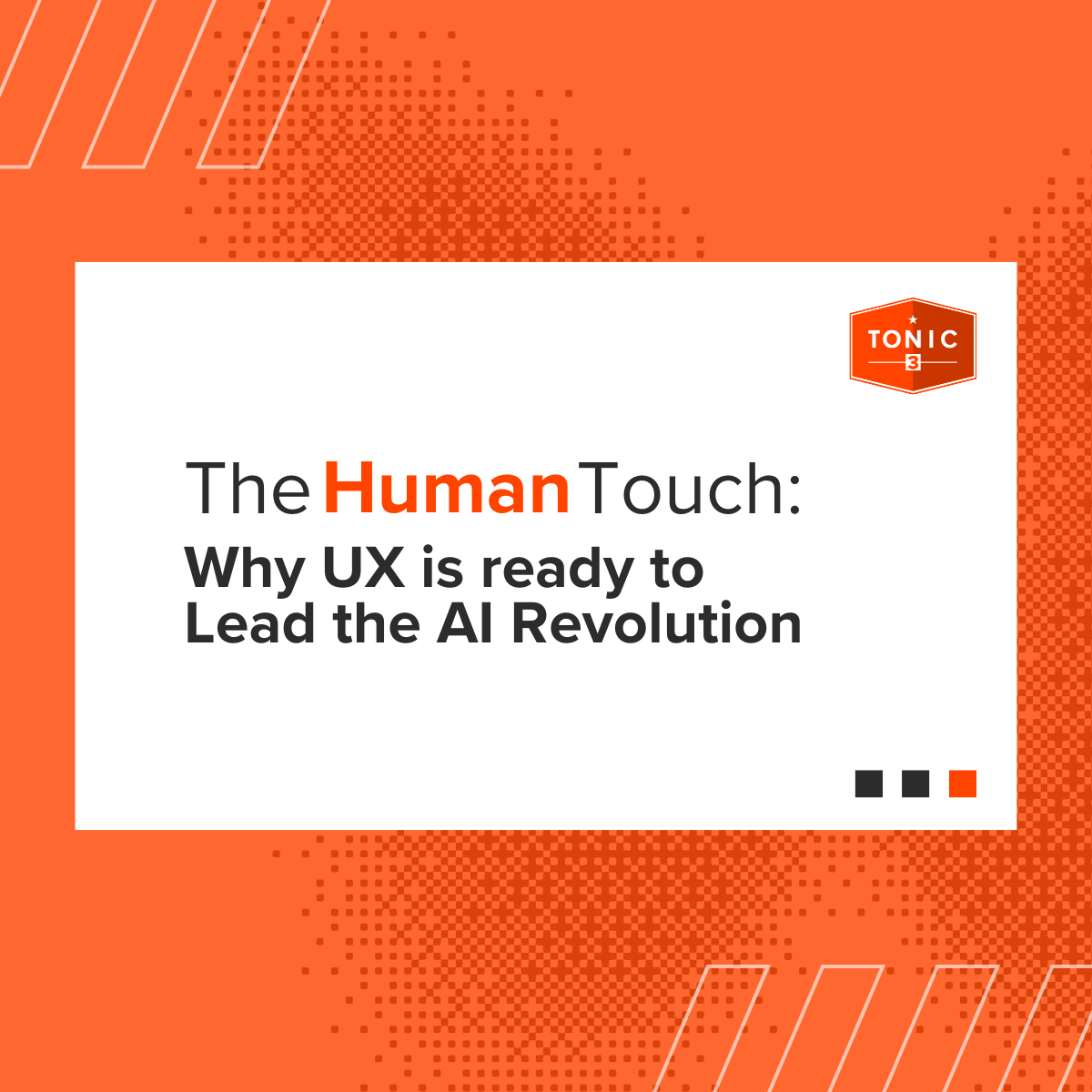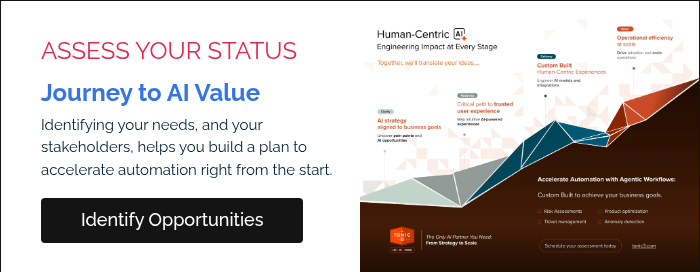The Human Touch: Why UX is ready to Lead the AI Revolution

From the days of hand-coded HTML in 1995 to today’s immersive AR/VR playgrounds and genAI explosion, at Tonic3, we've always been about using technology to make life better for people. But the purpose of technology isn’t to dazzle; it’s to help people thrive. The world is a better place when it’s People-centric, not Technology-centric—and AI is no different.
Tool or Magic Wand: UX in the Age of AI
AI has grown up over decades and is becoming truly revolutionary. But it’s still a tool, not a replacement for human creativity, empathy, or strategic thinking. To quote Christopher Nguyen from uxplaybook:
"There are crucial decision-making competencies that only humans possess, and they're invaluable in ensuring project success."
Put another way: AI is the hammer; we’re still the carpenters. (And sometimes, AI is the hammer trying to hammer a screw—impressive effort, questionable outcome.)
Here’s where AI still struggles:
- Precision: Ambiguous or complex queries often lead to irrelevant results.
- Predictability: AI can be an enigma, delivering surprises when you least need them.
- Transparency: It’s still a bit of a black box. How did it come to that decision? Shrug emoji.
Yann LeCun, Chief AI Scientist at Meta, has openly discussed these shortcomings, describing how today’s systems lack the reasoning and adaptability of human intelligence. In short, AI is a force multiplier, not the decision maker.
The Human Touch: A Timeless Design Principle
It’s easy to be seduced by AI’s shiny promise and jump into implementation before properly defining the problem. Like starting a road trip without a map — you will end up somewhere, but it’s probably not where you wanted to go. As Don Norman, a godfather of UX reminds us:
"Technology adds new dimensions to design, but the basic principles remain the same."
I once had a Creative Director who insisted designers sketch UX solutions with pen and paper before even touching their design software. The logic? Force human problem-solving before tech takes over. AI needs the same discipline: if you start with “What can AI do?” instead of “What problem are we solving?” you’re asking for trouble.
The better approach is to return to UX’s evergreen questions:
- Who is this for?
- What do they need to succeed?
- How can we deliver wins for both users and the business?
These questions are timeless for a reason—they keep us focused.
READ: Explore the benefits of prototyping in product and IT development

Don’t Skip the Homework: UX Lessons to Guide AI
Before unleashing AI, do the groundwork. User research remains the secret sauce of great UX. Talk to your users, observe them, and deploy tried-and-true methods like surveys, testing, and card sorting or any of the host of methods the UX community has built. Sure, AI can turbocharge these processes, but the foundational work? That’s still on us humans.
A human-in-the-loop (HITL) approach can further refine AI's output by incorporating real-time human feedback. Crystallize the problem. This is the make-or-break moment for any project. Misinterpreting the problem means wasting time, money, and effort solving the wrong thing.
The goal is for the end user, and the business doing the investment, to thrive. When we work with companies looking to scale or to connect with customers, we continue to ask if the strengths of AI match this goal. Can AI bring new and powerful value to solving the problems we’ve identified? If so, then we’ve found the right point for AI to shine.
Read more about our Generative AI customization services
AI: A Powerful Tool, When Used Wisely
Once the homework’s done and the problem is crystal clear, AI can step in to elevate the UX:
- Hyper-Personalization: As Kathy Baxter (personalization expert) notes, AI can tailor experiences to make every user feel uniquely seen.
- Predictive Analytics: It helps anticipate user needs. Think of it as a smart sidekick that’s always one step ahead.
- Natural Language Processing (NLP): Making interactions smoother and more intuitive—Alan Turing would be proud.
- Data Analysis: Unearthing hidden insights from mountains of data.
By pairing AI’s strengths with UX’s human-centered heart, we create experiences that:
- Move faster: Automating routine tasks means more time for strategic thinking.
- Work smarter: Hidden patterns and trends become actionable insights.
- Delight users: Predicting needs, personalizing interactions, and smoothing flows.
AI, The Multiplier for Human-Centered Progress
The golden rule? Start with people, not the tech. There was an interesting interview with composer Hans Zimmer about AI and music I heard recently and he discussed how AI cannot understand context and emotion the way humans do. AI is a superpower—a revolutionary tool that can redefine how we design and solve problems. But like any great power, it needs to be harnessed, directed, and deployed thoughtfully to serve human needs. Implementing a human-in-the-loop strategy ensures AI solutions remain aligned with human values and objectives.
When we ground AI in robust user research and timeless UX principles, it doesn’t just enhance experiences—it amplifies our ability to create meaningful, impactful solutions that help people and businesses thrive.
Frequently Asked Questions:
Generative AI enhances user experience design by integrating Human-in-the-Loop (HITL) methodologies, which prioritize human-centered design thinking. This approach ensures that AI systems are not only technologically advanced but also aligned with human needs and behaviors. By doing so, AI becomes a tool that enhances human capabilities, fostering a harmonious interaction between technology and users. This results in digital experiences that are efficient, effective, and personally resonant with users.
Hyper-personalization involves using AI to customize experiences so each user feels uniquely recognized. This approach ensures that interactions are more relevant and engaging for individual users.
Businesses can benefit from adopting Generative AI with HITL design by creating digital experiences that are tailored to the unique needs of their users. This approach allows businesses to develop AI solutions that enhance user satisfaction and engagement, ultimately leading to increased customer loyalty and retention. By focusing on human-centered design, businesses can ensure that their AI systems are not only innovative but also effective in meeting the evolving demands of their users.
AI can significantly elevate design thinking and the customer experience by offering hyper-personalization, predictive analytics, natural language processing (NLP), and data analysis. These capabilities allow AI to tailor experiences, anticipate user needs, smooth interactions, and uncover insights from data.
Predictive analytics helps anticipate user needs by analyzing patterns and trends. It acts like a smart assistant, always ready to provide insights that keep one step ahead of user expectations.


